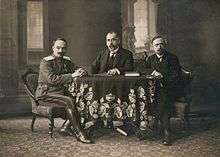Armistice of Salonica
The Armistice of Salonica (also known as the Armistice of Thessalonica) was signed on 29 September 1918 between Bulgaria and the Allied Powers in Thessaloniki. The convention followed a request by the Bulgarian government for a ceasefire on 24 September.


The armistice effectively ended Bulgaria's participation in World War I on the side of the Central Powers and came into effect on the Bulgarian Front at noon on 30 September. The armistice regulated the demobilization and the disarmament of the Bulgarian armed forces.
The signatories were, for the Allies, French General Louis Franchet d'Espérey, commander of the Allied Army of the Orient, and a commission appointed by the Bulgarian government, which was composed of General Ivan Lukov (member of the Bulgarian Army headquarters), Andrey Lyapchev (cabinet member) and Simeon Radev (diplomat).
Its importance was described by German Emperor Wilhelm II in his telegram to Bulgarian Tsar Ferdinand I: "Disgraceful! 62,000 Serbs decided the war!"[1][2]
On 29 September 1918, the Oberste Heeresleitung (German Supreme Army Command) informed Wilhelm and the German Chancelllor, Count Georg von Hertling, that Germany's military situation was hopeless [3]. On 14 October 1918, the Austro-Hungarian Empire asked for an armistice, and on 15 October 1918 Turkish Grand vizier Ahmed Izzet Pasha sent a captured British general, Charles Vere Ferrers Townshend, to the Allies to seek terms for an armistice.
Terms
The terms called for the immediate demobilization of all Bulgarian military activities. It ordered the evacuation of Bulgarian-occupied Greek and Serbian territories, placed limits and restrictions to the size of Bulgaria's military employment and required Bulgaria to return military equipment that had been taken from the Greek Fourth Army Corps during the Bulgarian occupation of Eastern Macedonia in 1916. German and Austrian-Hungarian troops were to leave Bulgaria within four weeks. Bulgaria and especially Sofia were not to be occupied, but the Allies had the right to occupy some strategic points temporarily and to transfer troops over Bulgarian territory.
According to Article 5, about 150,000 Bulgarian soldiers to the west of the Skopje meridian were to be delivered to the Entente as hostages.[4]
The French would send troops to Romania and the British and Greeks to European Turkey, which was still at war with the Allies.
The armistice would remain in effect until the conclusion of the Treaty of Neuilly-sur-Seine, the final general peace treaty, in November 1919.
References
- Editor. "The Battle of Dobro Polje – The Forgotten Balkan Skirmish That Ended WW1 | Militaryhistorynow.com". Retrieved 2019-11-21.CS1 maint: extra text: authors list (link)
- Editor. "The Germans Could no Longer Keep up the Fight | historycollection.co". Retrieved 2019-11-21.CS1 maint: extra text: authors list (link)
- Axelrod 2018, p. 260.
- Dimitrova, Snezhana. "Bulgarian Prisoners of War and Prisoners of War in Bulgaria (1915-1918): Law, Practices and Everyday Life. In: Mustafa Daş at al. First World War Centenary. Symposium Papers Book. Izmir; Dokuz Eylül University, 2015, pp. 443-463. ISBN 978-975-441-445-5". In: Mustafa DAŞ et al. 100. YILINDA BİRİNCİ DÜNYA SAVAŞI. DOKUZ EYLÜL ÜNİVERSİTESİ , 2015, pp. 443-463.
Sources
- (1919) "Bulgaria Armistice Convention, September 29th, 1918". The American Journal of International Law Vol. 13 No.4 Supplement: Official Documents, 402-404.
- Axelrod, Alan (2018). How America Won World War I. Rowman & Littlefield. ISBN 978-1493031924.CS1 maint: ref=harv (link)